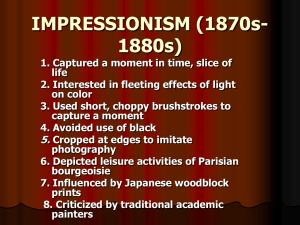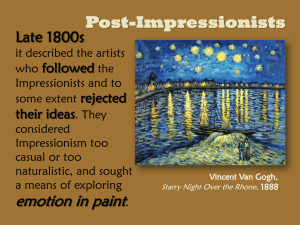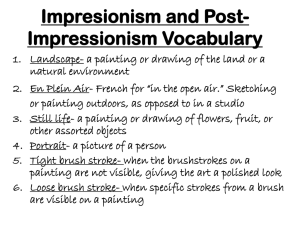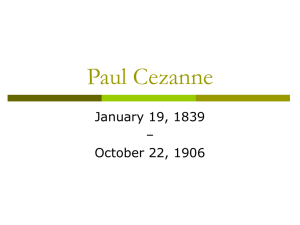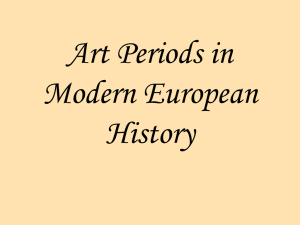CHP. 23- Post-Impressionism and the Late 19th Century
advertisement
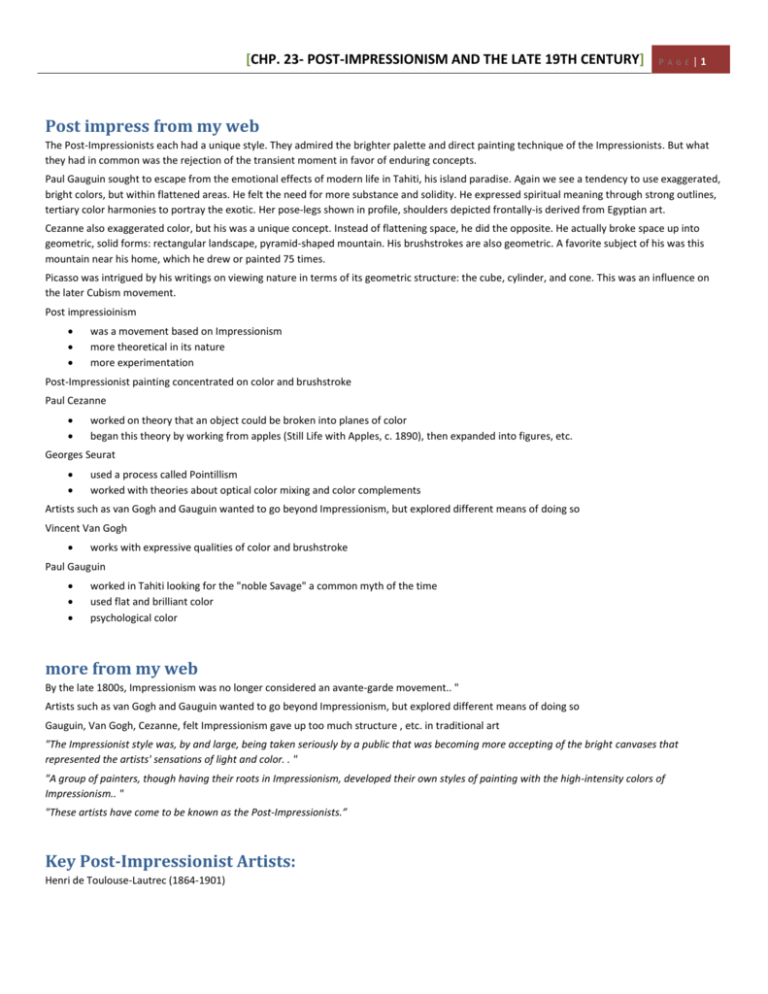
[CHP. 23- POST-IMPRESSIONISM AND THE LATE 19TH CENTURY] P A G E |1 Post impress from my web The Post-Impressionists each had a unique style. They admired the brighter palette and direct painting technique of the Impressionists. But what they had in common was the rejection of the transient moment in favor of enduring concepts. Paul Gauguin sought to escape from the emotional effects of modern life in Tahiti, his island paradise. Again we see a tendency to use exaggerated, bright colors, but within flattened areas. He felt the need for more substance and solidity. He expressed spiritual meaning through strong outlines, tertiary color harmonies to portray the exotic. Her pose-legs shown in profile, shoulders depicted frontally-is derived from Egyptian art. Cezanne also exaggerated color, but his was a unique concept. Instead of flattening space, he did the opposite. He actually broke space up into geometric, solid forms: rectangular landscape, pyramid-shaped mountain. His brushstrokes are also geometric. A favorite subject of his was this mountain near his home, which he drew or painted 75 times. Picasso was intrigued by his writings on viewing nature in terms of its geometric structure: the cube, cylinder, and cone. This was an influence on the later Cubism movement. Post impressioinism was a movement based on Impressionism more theoretical in its nature more experimentation Post-Impressionist painting concentrated on color and brushstroke Paul Cezanne worked on theory that an object could be broken into planes of color began this theory by working from apples (Still Life with Apples, c. 1890), then expanded into figures, etc. Georges Seurat used a process called Pointillism worked with theories about optical color mixing and color complements Artists such as van Gogh and Gauguin wanted to go beyond Impressionism, but explored different means of doing so Vincent Van Gogh works with expressive qualities of color and brushstroke Paul Gauguin worked in Tahiti looking for the "noble Savage" a common myth of the time used flat and brilliant color psychological color more from my web By the late 1800s, Impressionism was no longer considered an avante-garde movement.. " Artists such as van Gogh and Gauguin wanted to go beyond Impressionism, but explored different means of doing so Gauguin, Van Gogh, Cezanne, felt Impressionism gave up too much structure , etc. in traditional art "The Impressionist style was, by and large, being taken seriously by a public that was becoming more accepting of the bright canvases that represented the artists' sensations of light and color. . " "A group of painters, though having their roots in Impressionism, developed their own styles of painting with the high-intensity colors of Impressionism.. " "These artists have come to be known as the Post­Impressionists.” Key Post-Impressionist Artists: Henri de Toulouse-Lautrec (1864-1901) [CHP. 23- POST-IMPRESSIONISM AND THE LATE 19TH CENTURY] P A G E |2 Analytical approach: Paul Cezanne (1839-1906) Georges Seurat (1859-1891) Expressionistic approach: Vincent Van Gogh (1853-1890) Paul Gauguin (1848-1903) "Post-lmpressionist styles constitute a reaction to the superficial beauty of Impressionist works by stressing a more expressive, though not always realistic, approach to color and draftsmanship. The works of Paul Cezanne (1839-1906) established significant trends in painterly abstraction that influenced most later twentiethcentury artists. The Cubist painter Pablo Picasso called Cezanne, "the father of us all." Cezanne's admonition to interpret nature in terms of the cone, cylinder, and sphere is evident in his many stilllife paintings, although his landscapes of the rugged countryside around Mt. St. Victoire (near Aix-en-Provence) are perhaps best representative of his profound ability to abstract color and form from his natural subjects. Cezanne is regarded as one of the most influential artists of the modern period, a significant transitional figure that bridges the gulf between realism and abstraction in painting. (See Figure 5.96.) Other significant Post-Impressionist painters include:" "The emerging trend toward abstraction, evident in the last decades of the nineteenth century, signals the beginning of a new concept in painting. The idea of paintings as nonrepresentational aesthetic objects to be experienced and appreciated in their own right, rather than simply as copies of things in the world, emerges most fully in Vasily Kandinsky's entirely abstract watercolor paintings of 1910. Abstraction in all its various degrees and styles, combined with intensely personal expression, will form the conceptual and stylistic basis for much of twentieth-century art." 4 Post-Impressionism Impressionism, whose aim had been to translate the visual surface of reality onto canvas, had been the most challenging style of the 1870s. By the 1880s new tendencies had begun to develop within the members of the Impressionist group. Young painters like Seurat, Cezanne, Van Gogh, and Gauguin had all learned the lessons of Impressionism, but all felt the need to push beyond the limits of the style. These artists are all grouped under the heading of Post-Impressionism, but PostImpressionism is no single style, rather it is a group of individual styles all of which grew out of Impressionism. All of these artists accepted the highly keyed color of Impressionism, but they came to reject the idea that a painting should attempt to reproduce the visible world. Instead they believed that the task of the artist was to make visible a world that could not be perceived by the senses. The explorations of the Post-Impressionist artists went essentially in two directions. Seurat and Cezanne were both concerned with structure, with order. Seurat, whose Sunday Afternoon on the Island of La Grande latte is shown in Figure 21-80, used Impressionist light and color, but his forms are much more classic and controlled than any created on previous Impressionist canvases. He tried to combine the world of visual reality with classic structure and monumentality, and he admired the work of Piero della Francesca. He applied his colors very carefully, placing small dots of pure color next to each other on the canvas, allowing the eye to mix the colors to create the varied tones. Seurat believed that color was controlled by fixed laws that "could be taught like music." His theories were based on those of Delacroix and Chevreul, a scientist who worked at the Gobelins tapestry factory. The term "divisionism," which Seurat used, refers to the breakup of color into the small dots. His style is also called Neo-Impressionism and Pointillism. Cezanne, whose La Montagne Sainte-Victoire is shown in Figure 21-81, wrote that he "wanted to make of Impressionism a lasting art like that of the museums," and that he "wanted to do Poussin over again according to nature." He was particularly concerned with resolving the conflict between nature, which is three-dimensional, and the canvas, which is twodimensional. To this end he flattened planes, eliminated atmospheric perspective creating recession by pure color alone, working with small patches or modules of color, and locking together various areas of the canvas. Notice how the trunk of the tree in the foreground locks together both fore- and background and how its branches echo the form of the mountain in the distance. Other lines, like the lines delineating the fields, cut into depth. But in Cezanne's painting every thrust into depth is compensated by an equal return. Cezanne has created a tension between the three-dimensional forms and two-dimensional quality of the canvas, and it is this tension that gives a vitality to his art, as well as the tension between abstract forms and the forms of nature. In 1904 he wrote his now famous statement "See nature as a cylinder, sphere, and cone." Although Cezanne sought a geometric underpinning for his art, he never abandoned the forms of nature for those of the cylinder, the sphere, and the cone, as his followers the Cubists, were to do. Art for him was a struggle, but out of that struggle came his ideal, "Art as a harmony parallel to nature." 'Another Post-Impressionist path was taken by Van Gogh and Gauguin. These artists were not as concerned with form as were Seurat and Cezanne. Instead, their work embodied a spiritual response to nature. They transformed line into an expressive arabesque and color into expressive color. As you can see from Figure 21-85, Van Gogh's work is very different from Cezanne's, and their modes of working were very different, too. In the three years of his major production from 1886 to 1889 Van Gogh painted as many pictures as Cezanne produced in 50 years. In one of his many letters to his faithful brother Theo, Van Gogh wrote, "The emotions are sometimes so strong that one works without knowing one works, and sometimes the [CHP. 23- POST-IMPRESSIONISM AND THE LATE 19TH CENTURY] P A G E |3 strokes come with a sequence and coherence like words in a speech or a letter." Vincent's passionate intensity is apparent in this painting of the stars, which seem to writhe with an inner life of their own. The unconscious coherence of the rapid strokes is very different from Cezanne's careful modulation. While Cezanne was concerned with structure, Van Gogh was concerned with expression. Although the term Expressionism had not been coined when Vincent was painting, his work can be considered Expressionistic. Expressionists distort both the form and color of natural objects in order to emphasize their emotional content. Expressionist art is direct, impulsive, rapid, and its passion often attains a kind of ecstasy. Van Gogh said that he used color arbitrarily in order to express himself forcefully. Vincent had taken to walking at night and wrote that he had found a religion in the sky. In this painting he has moved into the realm of the visionary, the mystic, into the merger of individual consciousness with the cosmic forces of the universe. He has, with Figure 21-85, achieved the goal he wrote of: "To express the love of two lovers by a marriage of complementaries, their mingling and their opposition, the mysterious vibrations of kindred tones. To express the thought of the brow by the radiance of a light tone against a somber background. To express hope by some star, the eagerness of a soul by a sunset radiance." Paul Gauguin was a very different type of man from Van Gogh, but for both painting was a necessity and it furnished a kind of salvation for them. The work of both artists were symbols of their own emotions. As Gauguin said "The work of art for him who can see is a mirror wherein is reflected the state of the soul of the artist." The simplified color planes seen in works like Spirit of the Dead Watching (Figure 21-86) are the result of his contact with Japanese prints, his work with Van Gogh, and above all, the result of the influence of a young painter, Emile Bernard, who he had met in Brittany, who urged him to simplify and exaggerate. Bernard one said, "If half an object is green, paint it the greenest green you can." In this new style, Gauguin renounced light and shade, for he wanted to restore to color the value that the Impressionists had attributed to light. As he said, "color being an enigmatic thing in the sensations it gives you can logically only be used enigmatically, like musical sensations which proceeds out of its own nature, its own interior, mysterious enigmatic force.t'" "Gauguin attributed expressive symbolic qualities to line and color alike. "There are noble lines, lying lines, etc. A straight line signifies the infinite, the curve limits creation. Colors are even more indicative because of their effect on the eyes. There are noble tones, others that are common place, tranquil harmonies, consoling ones, and others which excite you by their boldness." For Gauguin, art was an abstraction, and he counselled artists to "derive the abstraction from nature while dreaming before it."" "Although the spiritual goals of Gauguin and Van Gogh on the one hand and the goals of Seurat and Cezanne on the other were divergent, and led to such divergent styles as Expressionism and Cubism, their common concern with the canvas as a flat plane laid the ground work for much of twentieth-century painting. Their common contribution can be summed up in the words of the painter" Maurice Denis: Remember that a picture, before being a war horse, a nude woman, or some anecdote, is essentially a plane surface covered with colors assembled in a certain order." Postimpressionist Movements For a brief period in the 1880s Pissarro was drawn to a new technique, an outgrowth of impressionism developed by Georges Seurat, known as divisionism or pointillism. Seurat and his neoimpressionist followers modified the loose brushstrokes characteristic of impressionist style into precise dots of pure pigment, juxtaposing tiny areas of complementary colors on the canvas surface. Seurat's theories were derived from his readings in 19th-century scientific and aesthetic texts on color. The result of his painstaking technique is supremely visible in one of his most spectacular works, Sunday Afternoon on the Island of the Grande Jatte (1884-1886, Art Institute of Chicago). Three major artists of the late 19th century showed influences of impressionism in their early works but went on to develop distinctively individual postimpressionist styles: the Dutch-born Vincent van Gogh and the French artists Paul Gauguin and Henri de Toulouse-Lautrec. Van Gogh, like Pissarro, experimented briefly with color division. Typical of his developed style, however, was the use of pure color applied thickly in flickering strokes, conveying intense emotional expression. Many of his canvases, especially those of wind-tossed cypress trees and wheat fields under stormy skies, are expressions of his own moods as reflected in the forces of nature. Van Gogh's style greatly influenced the northern European painters who in the early 20th century developed expressionism. The work of his colleague Gauguin also displays distortions of line and color, but it is quite different from van Gogh's, being symbolic rather than expressionistic. Areas of flat, bold colors form decorative patterns, heavily outlined. Gauguin was the central figure of a new movement known as synthetism or symbolism (see Symbolist Movement); his immediate followers, a group active during the 1890s, were called the Nabis. In still another direction, Toulouse-Lautrec was largely a painter of people, choosing as his subjects cabaret singers, dance-hall performers, and prostitutes; these figures were an expression of the social decay of Paris in the so-called Gay Nineties. Like many artists—such as Manet, Degas, and the American Mary Cassatt—he was influenced by the flat style and seemingly casual composition of Japanese prints. Toulouse-Lautrec's excellent sense of line is seen also in his drawings and color lithographs; he contributed greatly to this last medium, particularly with his posters for the Moulin Rouge and other Parisian places of entertainment. See Postimpressionism. Post-Impressionism and the Late Nineteenth Century [CHP. 23- POST-IMPRESSIONISM AND THE LATE 19TH CENTURY] P A G E |4 “Post-Impressionism” “By the late 1800s, Impressionism was no longer considered an avante-garde movement. The Impressionist style was, by and large, being taken seriously by a public that was becoming more accepting of the bright canvases that represented the artists' sensations of light and color. A group of painters, though having their roots in Impressionism, developed their own styles of painting with the high-intensity colors of Impressionism. These artists have come to be known as the Post­“ “Impressionists.” Post-Impressionist Painting Henri de Toulouse-Lautrec “Henri de Toulouse-Lautrec” “Henri de Toulouse-Lautrec (1864-1901) also recorded his impres-sions of his environment. Though of the upper class, he was self-con-scious of his dwarflike appearance (he had injured his legs in child-hood) and chose to associate with the denizens of the gaudy nightlife of Paris. Like Degas, Toulouse-Lautrec's use of space in his composi-tions was influenced by Japanese prints, as seen in his use of diagonals in his painting At the Moulin Rouge (1892). He exaggerates the forms of his composition through the use of harsh colors in juxtaposition. Though not as extreme in his simplification of forms as Cezanne, Toulouse-Lautrec does reduce the distinctness of drapery and the features of his subjects in order to work in broader fields and planes of color.” Paul Cezanne “Paul Cezanne” “Paul Cezanne (1839-1906), not content with what he perceived to be a lack of form in Impressionism, returned to nature in order to investigate the relationship between color and structure. His use of color as a means of portraying the structure, mass, and volume of forms is seen in his painting La Montagne Sainte-Victoire (1886-1887). Here, he has reduced the forms of nature and humans to faceted planes of color, a technique and manner that the later Cubists would take to a greater extreme. He does the same in an even earlier work, Christ in Limbo (1868-1870); here he has reduced even the shadows to planes of color.” “Cezanne's reduction of form and his attention to form's geometric” “basis may also be seen in Fruit Bowl, Glass, and Apples (1879-1882) and Still Life (1890), in which the objects represented seem more like geometric shapes than the actual objects. This manner of geometric ordering is seen, too, in his figure depiction, as in Boy in a Red Vest (1893-1895). Not only have the figure and drapery been reduced to geometric planes, but the actual scale of elements has been altered in order to create a more balanced two-dimensional image. Like the Impressionists, Cezanne detached himself emotionally from his subject. In doing so, he felt free to distort and reorganize his subject in compos­ing his painting.” An Apple a Day Georges Seurat “Georges Seurat” “Georges Seurat (1859-1891) worked very analytically and sys-tematically, painting small dots in color fields, a method he referred to as divisionism, also called pointillism. In theory, the dots would "blend together" when viewed from a distance. Though that does not occur to the extent Seurat may have wished, the shimmering effect is, nonethe-less, striking. The theme of his painting The Bathers (1883-1884) was not an uncommon one among the Impressionists, but his manner of working with minute brush strokes belies the immediacy of the image. One of the most famous of his works, A Sunday Afternoon on the Island of La Grande Jatte (1884-1886), reflects his efforts to organize and systematize the application of pigments through an intellectual ap-proach. Invitation to the Side Show (La Parade) (1887-1888) was also painted in this manner, though Seurat, in this case, reduced the minute brush strokes to even smaller dots of color, with the result that his figures seem even more ethereal than those in his earlier works [see illustration 121.” Vincent van Gogh [CHP. 23- POST-IMPRESSIONISM AND THE LATE 19TH CENTURY] P A G E |5 “Vincent van Gogh” “While Seurat and Cezanne approached their art analytically, Vin­cent van Gogh (1853-1890) pursued art as a means of expressing his deepest thoughts and feelings. Even before Van Gogh saw the work of the Impressionists and their palette of bright color, his work possessed expressive power, as seen in The Potato Eaters (1885). After his exposure to the Impressionist painters in Paris, his canvases vibrated with color. His perception of the expressive qualities of color extended to the heavy manner in which he applied the pigment to canvas, and he felt that the surface textures he created through his brushwork were important to the overall effect of his compositions. His expressive use of color, which sometimes led critics to refer to his work as Expres-sionistic, can be seen in his painting The Night Cafe (1888), in which the harsh hues he uses convey a feeling about the place, albeit a negative one, rather than depict a true image of it.” “Van Gogh's painting of his room in Arles, The Artist's Room at Arles (1888-1889), conveys a sense of loneliness. Containing little more than a bed, two chairs, and a small table with the artist's personal articles, the room seems bare and small, with everything pushed to the far wall, leaving what seems to be an excessive amount of floor space in the foreground. Van Gogh produced many of his landscape paintings during the two years he spent in Arles, in southern France. There, he translated the staid environment around him into vistas of motion and movement. In his painting Wheat Field and Cypress Trees (1889), Van Gogh sees movement in both the land and the sky, and he represents them with an equal amount of energy. His self-portraits have the same vitality of color, as seen in his Self-Portrait of 1889. Van Gogh's expressive approach to painting is also reflected in The Starry Night (1889), which is not a portrayal of the night sky as it is familiarly seen, but the artist's very subjective perception of it, transformed into brush strokes on the two-dimensional surface of the canvas.” Paul Gauguin “Paul Gauguin” “Like Van Gogh, Paul Gauguin (1848--1903) is known for his nontraditional use of color and his desire to achieve a greater sense of solidity than could be achieved through light alone. Gauguin is known especially for his exotic images of life in Tahiti, and his use of intense color planes in this work is the result of his interest in expressing imagery in a personal manner. His respect for and infatuation with the "primitive" life-style he found first in Brittany, then in the South Pacific, and the integral role that religion played in these cultures are apparent in his selection of themes, his use of bright colors, and the decorative quality of his paintings.” “As a "modern" man living in a"primitive" culture, Gauguin produced images that reflected his interpretation of his surroundings, as seen in his paintings The Vision after the Sermon (Jacob Wrestling with the Angel) (1888) painted in Brittany, and The Spirit of the Dead Watching (1892) painted in Tahiti. NAAFI Faaipoipo (When Are You to Be Married?) (1892), also painted in Tahiti, represents a particular characteristic of his style. Here, the images of the two women who are the subjects of the painting, as well as the elements that make up the landscape, are flattened out as broad areas of color.” Artists Quote Art: Thompson, Gauguin, and Cranach (See 854) Window on the World Ten Gauguin and Oceania (See 852) Symbolism Overview "Some artists before the turn of the 20th century created haunting, shocking, terrifying and nightmarish visions" Key Artists Gustave Moreau (1826-1898) Gustav Klimt (1862-1910) Odilon Redon (1840-1916). James Ensor (1860-1949) [CHP. 23- POST-IMPRESSIONISM AND THE LATE 19TH CENTURY] P A G E |6 Edvard Munch (1863-1944) Gustave Moreau The Symbolist Movement others as being a Symbolist. His painting Death and Life (1908, 1911), these latter critics feel, is representative of the Symbolist manner in its theme and execution. Influenced by his interest in and exposure to Byzantine art, Klimt's painting consists of flat areas of ornamentation with emerging contrasting organic forms that possess mass and volume.” “Odilon Redon” “Perhaps most often associated with the Symbolist movement is the work of Odilon Redon (1840-1916). Though a contemporary of the Impressionists, Redon felt that the Impressionist manner was too con-fining and directed his attention toward the role of the imagination in art. His paintings, such as Anemones (1908), reflect his efforts at integrating reality as he saw it with reality as he felt it. Though he spent much time observing nature, his paintings and lithographs, such as In a Dream (1879), reflect his imagination and inner dream world. As Symbolism became popular in the 1880s, Redon's work was acknow-ledged by many of the Symbolists as representing their philosophy, and he was admired by such artists as Gauguin and Matisse.” “James Ensor” “Other artists, such as the Belgian painter James Ensor (1860-1949), continued to produce works that challenged societal norms. One of Ensor's most famous works, which was considered offensive when it was first exhibited, is The Entry of Christ into Brussels (1888). Here, Christ is portrayed with an entourage of bizarre masked figures. Ensor's perception of humankind as possessing little substance and humaneness is conveyed through his use of harsh color and the dark, festive nature of the scene. Another dark carnival-like image is found in Ensor's Intrigue (1890). At first glance the celebrants seem to be wearing masks, but upon closer examination it becomes evident that these are in fact their faces.” Edvard Munch “Edvard Munch” “Like Ensor, the Norwegian Edvard Munch (1863-1944) is known for his depiction of the dark side of humankind. His painting The Scream (1893) depicts in a powerful manner the inner torment of the individual as an isolated being. The scream emanating from the foreground figure seems to radiate throughout the painting by way of the brush strokes Munch has laid on the canvas.” Fin de siecle Developments (See 858) Aestheticism (See 858) Art Nouveau (See 858) “Art Nouveau” “The Art Nouveau style was an international phenomenon (known as Secessionstil in Austria, Jugendstil in Germany, and the Liberty Style in England) that was popular between 1890 and 1910. A decorative art, it was characterized by sinuous, serpentine line and organic, foliate forms that were a reaction to the encroaching industrialization of the Western world. As a contemporary movement that responded to the growing mechanization of industry and the resulting mass production of products, the Art Nouveau style represented a concern for craftsman-ship and the handmade object. Though it was primarily a decorative art, it was also used effectively, though with some difficulty, in the domain of architecture.” “The Art Nouveau Style in Architecture” “Some of the finest examples of the Art Nouveau style may be seen in Vienna, Austria. The Secession Building, designed by Joseph Olbrich, was based upon a drawing by Gustav Klimt. It is similar in form to the ancient Egyptian mastaba, but capped with a metal dome that is decorated in a leaflike pattern. Another example of the Art Nouveau style in architecture is Otto Wagner's Postal Savings Bank (1904-1906, 1910-1912), whose [CHP. 23- POST-IMPRESSIONISM AND THE LATE 19TH CENTURY] P A G E |7 structure is covered with thin slabs of marble, revealing a sense of the underlying framework of the building. Wagner, too, made use of a laurel-leaf motif. Through the use of strong horizontal elements, such as the pair of protruding overhangs above the public entrance to the building, he stressed the horizontal axis of the structure rather than the vertical.” “Internationally, the Art Nouveau style was interpreted in different ways. An example of the Art Nouveau style used in the interior of a building is the ornamental iron staircase (1895) in the Hotel van Eet-velde in Brussels, which was designed by Victor Horta (1861-1947). The design of Charles Rennie Mackintosh (1868-1928) for the north facade of the Glasgow School of Art (1896-1910) substituted sunken windows for the outer walls and included an open two-story library whose visible wooden supports also visually reinforced its vertical orientation. The shape of the Werkbund Exhibition Theatre (1914) in Cologne, designed by the Belgian Henry van de Velde (1863-1957), reflected the outer contours of the modules that made up the structure.” “One of the most remarkable structures, created in the most radical interpretation of the Art Nouveau style, was the Casa Mild (1905-1907), an apartment building in Barcelona, Spain. Designed by Antoni Gaudy (1852-1926) who, in his architecture, attempted to recreate the organic movement of forms in nature, it represents an extreme application of the paradigm of natural form. There are few linear qualities or level surfaces to this building, whose asymmetrical surface seems to oscillate like rock that has been eroded for centuries.” The Vienna Secession (See 860) Henri Rousseau (See 862) “Henri Rousseau” “Another artist known for his primitive style is Henri Rousseau (1844-1910). Though considered naive by many of his contemporaries, “Rousseau's dreamlike images are quite captivating. His painting The Sleeping Gypsy (1897) reflects this quality in the manner in which he has depicted the lion and the sleeping figure; the image created is almost disturbing in its portrayal of a person's vulnerability when asleep. A later work, The Dream (1910), possesses these same qualities [see illustration 14]. In this painting, however, Rousseau has created a color-saturated jungle, an exotic environment for the main subject of the painting-a female nude who gestures to a native playing a horn while under the watchful gaze of two lions, one of whom stares straight at the viewer.” Mechanisms of Dreaming (See 863) Part --: Unit Exam Essay Questions (from previous Art 261 tests) Compare Impressionism with Post-Impressionism. Consider style and iconography. Compare and contrast Expressionism with Fauvism. Use examples in your text. Discuss the relationship between Cezanne and Analytic Cubism. How did one influence the other? Compare Rothko and Pollock. What is similar in their respective developments. What is the essential difference in their approaches to painting? Compare the iconography of Pop Art with that of Realism and Impressionism. Using the examples in your text, discuss the similarities and differences, as well as the relevance to the time and place in which the style flourished. Using examples from the text, compare Rococo and Neoclassical style. Consider context, iconography, and formal elements. Using the examples in your text, compare Realism with Impressionism from the point of view of style, social or theoretical intention, and subject matter. Compare Impressionism with Post-Impressionism. Consider style and iconography. Compare and contrast Expressionism with Fauvism. Use examples in your text. Discuss the relationship between Cezanne and Analytic Cubism. How did one influence the other? [CHP. 23- POST-IMPRESSIONISM AND THE LATE 19TH CENTURY] P A G E |8 Compare Rothko and Pollock. What is similar in their respective developments. What is the essential difference in their approaches to painting? Compare the iconography of Pop Art with that of Realism and Impressionism. Using the examples in your text, discuss the similarities and differences, as well as the relevance to the time and place in which the style flourished. Beginning with Impressionism, discuss the influence of photography on the visual arts. (from AAT4) Compare the development of Cézanne's palette with that of Manet and van Gogh. Cite examples in the text. What caused the changes? Compare Moreau's imagery and style with Impressionism and Post-Impressionism. How does the application of paint and the use of color differ, and how do they affect the meaning of the works? Using the two examples in the text, discuss characteristics that are Symbolist and others that are Post-Impressionist in the work of Munch Identify and describe the different artistic movements at the end of the nineteenth century. Identify the psychological states of mind in Gauguin's Nevermore and Munch's The Scream. How do the artists construct their paintings to convey these states? Compare and contrast the styles of Gauguin and van Gogh, with an emphasis on brushstrokes, color, and arrangement. Learning Goals (AAT4) After reading Chapter 23, you should be able to do the following: Identify the works and define the terms featured in the chapter Compare Post-Impressionism with Impressionism Trace the development of style and subject matter in Cézanne's paintings Identify the characteristics of pointillism Trace the development of color in the work of van Gogh Discuss the influence of Japanese prints on Post-Impressionism Compare Symbolism with Post-Impressionism Describe Gauguin's relationship to Tahiti and to Oceanic art Discuss fin de siècle Aestheticism in Europe Define the characteristics of Art Nouveau architecture and design Discuss the Vienna Secession Relate Freud's theories of the mechanisms of dreaming to Rousseau's The Dream Chapter Outline (AAT4) POST-IMPRESSIONISM AND THE LATE 19th CENTURY Toulouse-Lautrec Cézanne's "constructive brushstroke" Seurat's Pointillism van Gogh; Gauguin The Symbolist movement: Moreau; Munch Aestheticism: Wilde; Beardsley Art Nouveau: Horta; Guimard; Gaudí Vienna Secession: Klimt Freud, The Interpretation of Dreams (1899) Rousseau, The Dream (1910) Gauguin and Oceania [CHP. 23- POST-IMPRESSIONISM AND THE LATE 19TH CENTURY] P A G E |9 AAT4 Key Terms none Summary and Study Guide pointillism Symbolism femme fatale Japanese prints Art Nouveau additive sculpture Vienna Succession (founded 1897) Artist Quotes Cézanne: “I want to make of Impressionism something solid and lasting like the art in the museums.” Maurice Denis: “We should remember that a picture–before being a war horse, a nude woman, or telling some other story–is essentially a flat surface covered with colors arranged in a particular pattern.” (1890) van Gogh: “I have tried to express the terrible passions of humanity by means of red and green.” Munch: “I felt the great scream throughout nature.” Art Works know these works by sight, title, date, medium, scale, and location (original location also if moved) and be able to explain and analyze these in relation to any concept, term, element, or principle. After impressionism, but not really part of post‐impressionism the movement – Henri de Toulouse‐Lautrec, At the Moulin Rouge, 1892‐1895, oil on canvas [AIC] Post‐Impressionism Georges Seurat, Sunday Afternoon on the Island of La Grande Jatte, 1884‐1886, oil on canvas [AIC] Paul Cézanne, various paintings of Mont Sainte‐Victoire Paul Cézanne, various still‐lives Vincent van Gogh, The Night Café, 1888, oil on canvas Vincent van Gogh, Starry Night, 1889, oil on canvas Vincent van Gogh, Bedroom at Arles, 1889, oil on canvas [AIC] Paul Gauguin, The Vision after the Sermon (Jacob Wrestling with the Angel), 1888, oil on canvas Paul Gauguin, Where Do We Come From? What Are We? Where Are We Going?, 1897, oil on canvas Symbolism GUSTAVE MOREAU, Jupiter and Semele, ca. 1875. Oil on canvas, 7’ x 3’ 4”. Odilon Redon, The Cyclops, 1898, oil on canvas Edvard Munch, The Scream, 1893, oil on canvas Aubrey Beardsley, Salome, 1892, pen and ink drawing ze Vienna Succession Gustav Klimt, The Kiss, 1907‐1908, oil on canvas "The Vienna Secession or (also known as Secessionsstil, or Sezessionsstil in Austria) was part of that highly varied movement that is now covered by the general term Art Nouveau. It was formed in 1897 by a group of 19 Vienna artists who had resigned from the Association. The first President was Gustav Klimt." Style of the Secessionists [CHP. 23- POST-IMPRESSIONISM AND THE LATE 19TH CENTURY] P A G E | 10 "Unlike other movements, there is no one style that unites the work of all artists who were part of the Vienna Secession. The Secession building could be considered the icon of the movement. Above its entrance was carved the phrase "to every age its art and to art its freedom". "Secession artists were concerned, above all else, with exploring the possibilities of art outside the confines of academic tradition. They hoped to create a new style that owed nothing to historical influence. In this way they were very much in keeping with the iconoclastic spirit of turn-of-thecentury Vienna (the time and place that also saw the publication of Freud's first writings)." "The Secessionist style was exhibited in a magazine that the group produced, called "Ver Sacrum", which featured highly decorative works representative of the Art Deco period." "Secessionist architects often decorated the surface of their buildings with linear ornamentation in a form commonly called whiplash or eel style. Otto Wagner's Majolika Haus in Vienna (c. 1898) is a significant example of the Austrian use of line." "Otto Wagner's way of modifying Art Nouveau decoration in a classical manner did not find favour with some of his pupils who broke away to form the Secessionists. One was Josef Hoffmann who left to form the Wiener Werkstätte, an Austrian equivalent of the Arts and Crafts Movement. A good example of his work is the Stoclet House in Brussels (1905)." Other Secession artists Gustav Klimt Egon Schiele Oskar Kokoschka Discussion topics for this chapter. Compare the development of Cèzanne's palette with that of Manet and Van Gogh. Cite examples in the text. What caused the changes? Compare Impressionism with Post-Impressionism. Consider style and iconography. Other topics to consider: Compare the imagery of Moreau with that of Post-Impressionism and Impressionism. How does the application of paint and the use of color differ, and how do they affect the meaning of the works? Using the two examples in the text, explain what is Symbolist and what is Post-Impressionist in the work of Munch. Identify and describe the different artistic movements at the end of the nineteenth century. Identify the psychological states of mind in Gauguin's Nevermore and Munch's Anxiety. How do the artists construct their paintings in order to convey them?


